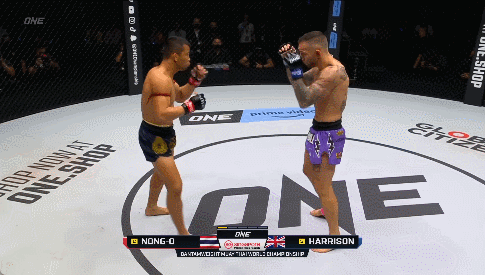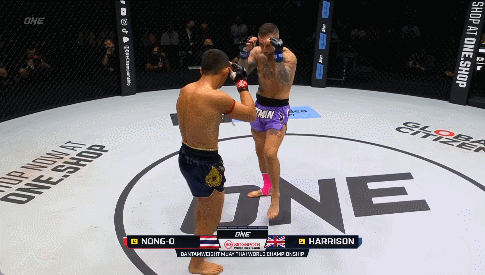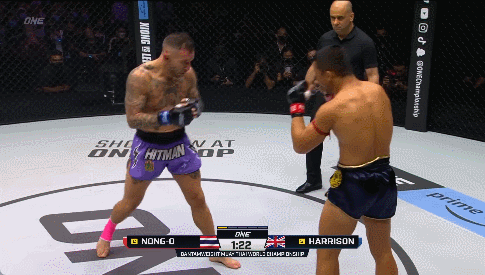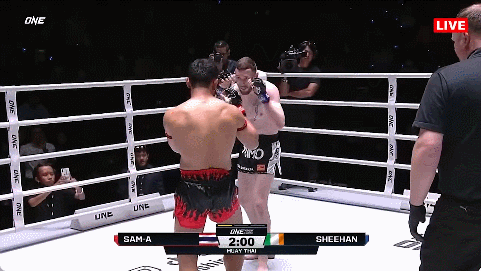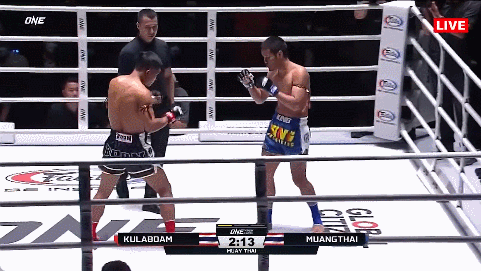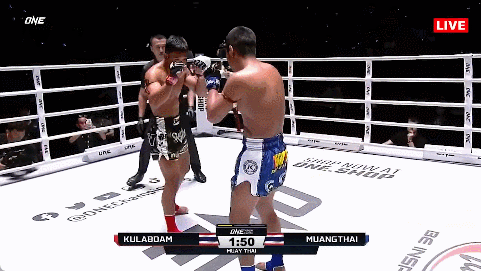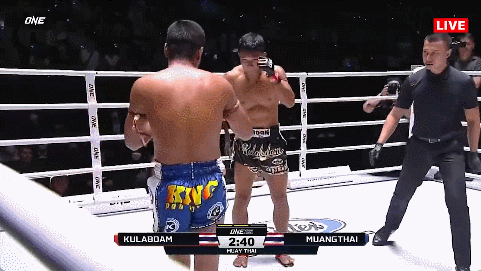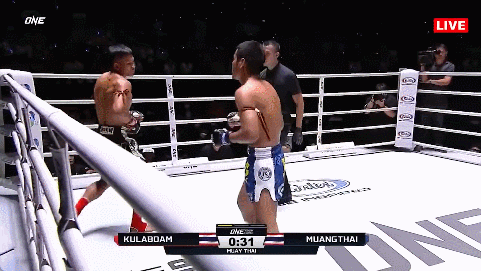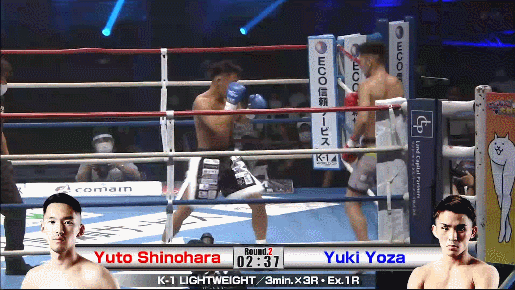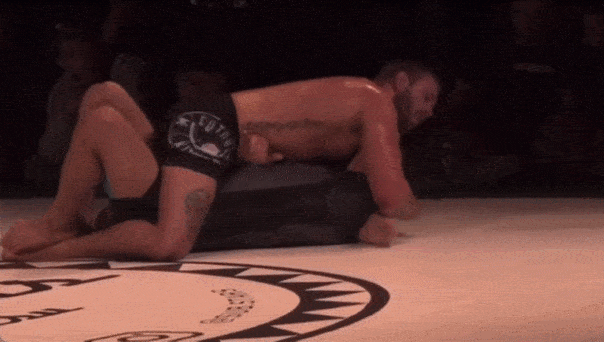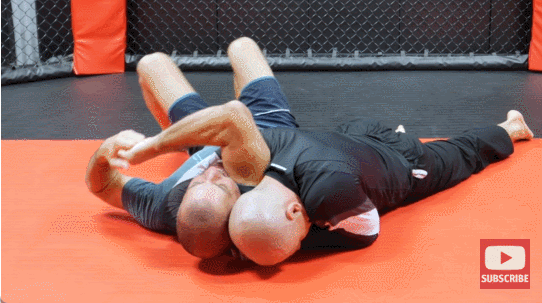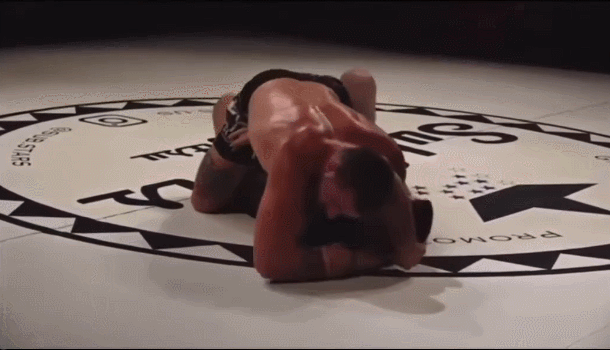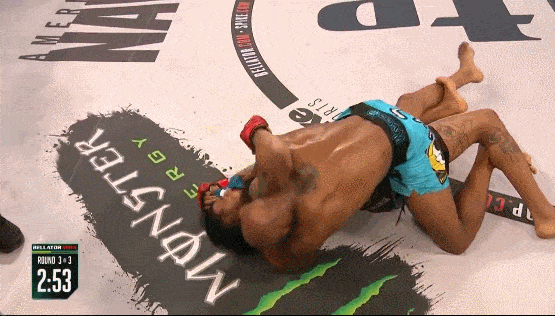Some Thoughts on the Calf Kick and the Arm Triangle
Due to the unrelenting fight schedule, it has been some time since we examined techniques and current trends with visual aids. As there is this week a break in the constant stream of UFC cards, it seems a good time to study some moments from recent fights that got this writer thinking about larger themes.
Calf Kicking in High Level Striking Sports
As the calf kick took over the MMA sphere, kickboxing and Muay Thai fans were quick to scoff that this would never happen in their sports. There was certainly a degree of truth to that: from about 2015 MMA fighters were shuffling up to their opponents and throwing naked, rear leg, full power calf kicks and scoring them clean. Yet there has also been an uptick in calf kick usage and legitimate calf kick stoppages in kickboxing too. Because drop foot is drop foot and a better striker might not get hit by long, telegraphed calf kicks, but his lower leg is a vulnerable point just the same.
To understand low-low kicking with a bit more depth and subtlety you need only look at Nong-O versus Liam Harrison from last year. Harrison has checked a million low kicks in his life, and discussed the calf kick a year earlier on his podcast with some other British Nak Muay. In fairness to Harrison, he was the one making the case for the target being legitimate.
The lesson of the Nong-O - Harrison fight is that sometimes a check isn’t a check. It all comes down to shin angle and if the defending fighter doesn’t get his shin pointed out into the brunt of kick, he can end up eating a nasty connection while the commentators declare that he checked the kick nicely.
And one of the weapons that enabled Nong-O to put in that low kicks just a split second faster than Harrison could get to the check was the teep to the lead leg.
In non-MMA striking sports, straight kicks to the lead leg are mainly an annoyance, but that doesn’t mean they do nothing. The best way to receive straight kicks to the lead leg is to pick the leg up and point the knee straight into the kick, or to put weight onto the leg—again, pointing it straight into the kick. That slight difference of angle between absorbing a straight kick and checking a round kick is something that can be brought to lever at the elite levels.
Nong-O went between push kicks to the thigh, round kicks below the knee, and a floating step to enter with his punches and he did it excellently, stopping the British legend inside the first round. But the beauty is in the mix ups. The fight between Ryan Sheehan and Sam-A last weekend is a great example of how nothing works if you’re too obvious.
Jonathan Haggerty had success against Sam-A by pairing the teep to the lead leg and the switch kick to the lead leg, as well as using a fake teep to float step into punching flurries.
Sheehan ran into the problem that his flurries and his needling teeps to the lead leg were too obviously separate. When he wanted to attack, he would shift in and start swinging, getting caught with Sam-A’s counter left hand. When he wanted to keep Sam-A off him he would teep the lead leg two or three times in succession and Sam-A would read this.
With no demonstrated dynamic threat of high kicks or round kicks off the lead leg, Sam-A was free to reach down and knock Sheehan’s lead leg offline, taking the outside angle and lancing him with a left straight as he did so.
While I brought this fight up to contrast Sheehan’s unvarying use of the teep to the lead leg with Nong-O’s dynamic use of it, there were a couple of other interesting points. Sam-A is a man with over 400 fights and you could see that when Sheehan caught Sam-A’s kicks. Even with Sam-A on one leg and apparently over a barrel, Sheehan couldn’t get close enough to attack the shorter, hopping Thai. Eventually Sam-A began using Sheehan’s leg grabs to land elbows on the side that Sheehan’s hand was occupied.
Returning to Nong-O and calf kicks, or low-low kicks, or even the idea of getting behind the check: Muangthai’s fourth fight with Kulabdam was a good showcase. Against a fellow southpaw, Muangthai spent the first and second round trying to walk around to the left and throw in his low kick from just outside Kulabdam’s lead leg.
Notice Muangthai’s crumpled up, “kick myself in the head” teep that I mentioned on the podcast. Ugly but it does the job.
And of course getting to the better kicking angle is even easier to attain when you can catch or parry the opponent’s kick and have them do half the turning for you.
By gently but constantly curving himself around the to the outside of Kulabdam’s lead leg, Muangthai could give himself the favourable kicking angle even when Kulabddam checked. Once Kulabdam was aware of this it also meant Muangthai could get Kulabdam to pre-emptively check just by side stepping. Muangthai used this to throw a curveball and enter with punches a few times.
Our two ideas up until now—straight kicks to the lead leg and angling around to the side—have been ways of landing kicks to the calf of a good opponent even when he picks his leg up to check. A third idea MMA fighters should be stealing from Muangthai is his follow up from the low-low kick.
Muangthai used a kick well below the knee to take a low risk shin-on-shin connection, in order to place his foot down immediately in under the check and move into the clinch. This is, after all, Muangthai—if he is not the greatest elbow fighter going, he’s certainly the most enthusiastic.
There aren’t a lot of fighters lunging for long clinches in MMA, but Muangthai’s use of the low-low kick as a clinch entry is an important lesson. Five years after the calf kick became big, fighters are still attempting it and then either succeeding or failing based on whether the opponent even knows how to defend themselves. Therein is the difference between MMA and high level kickboxing and Muay Thai: the best kickboxers and Nak Muay use the kick knowing the opponent will defend himself.
Before we move onto our last example of successful calf kicking in high level striking sports, I want to shine a light on another beautiful Muangthai clinch entry from the Kulabdam fight. Using the step up lead leg high kick to the guard to off balance Kulabdam—as Jean Charles Skarbowsky advises you should—Muangthai steps around to the left, checks the hands and enters with an elbow from the flank. Muangthai then proceeds to chop Kulabdam up with some elbows and you even get a rare sighting of what we MMA folk all called the “Mooey Thai Plumm” in 2005, in a real Muay Thai fight.
Our last example of working the calf kick against competent kickboxers comes from Yuki Yoza. Yoza just became the K-1 lightweight champion and he has been tearing up the K-1 ring with what he calls the Yoza kick—which he jokes was banned on his first day training in the Netherlands.
The Yoza kick is a front snap kick into the opponent’s rear leg. Yoza was a Kyokushin world champion at 19 and of course, kicking both of the opponent’s legs is commonplace in Kyokushin, because the fighters are mostly trading body punches from an almost chest-to-chest distance. In kickboxing it is a little harder to hit the opponent’s back leg with your own if you are both in the same stance. By a front kick into the quad instead of trying to hit with the shin, Yoza covers as much ground as he can with the kick.
The calf kick is made harder to land by the opponent being aware of it and fighting cautious on his lead leg. Yoza’s assault on his opponent’s back leg often has them moving their weight from one foot to the other, whether they are trying to check with the back leg or push kick him off. When Yoza uncorks the regular calf kick, his opponent isn’t ready for it.
Don’t hold out hope for a rise of Yoza kicks in the UFC, but know that it is out there and it is far more effective that most people believe. Nicholas Pettas was on commentary for this Yoza fight and kept insisting that you will never hurt anyone by kicking their back leg. Here is Japanese cruiserweight, Seiya Tanigawa dropping his opponent with the first one thrown.
Gilbert Burns Arm Triangle
A couple of months ago, Gilbert Burns cut through Neil Magny with an ease that even his biggest fans could not have expected. The wily old journeyman Magny had nothing for Burns, who easily took him to the mat along the fence and worked himself up to a fight-ending arm triangle choke.
The traditional path of the kata-gatame or arm triangle choke is to work to mount, raise one of the opponent’s elbows until it can be captured along with the head, secure the grip, and then dismount to finish. Upon dismounting most fighters drop their hips next to their opponent’s, or if the tap is not forthcoming, they will begin walking around the clock to perpendicular with the opponent to secure the finish. It’s the most common finish because it is probably the most powerful and you can see Gordon Ryan scoring submissions with it regularly.
The downside of the dismount is that it frees the opponent’s legs. This means that he can attempt one of a couple of escapes. He can bridge into the top man, he can slip his elbow inside the lock and nullify the arm triangle. Controversial grappling mad man, Tex Johnson demonstrated this against the aforementioned Gordon Ryan:
Or the bottom man can attempt to turn away. This is combined with an attempt to relieve the pressure into his trapped shoulder, which is driving into his neck. That could be using the free hand to pull the top man’s shoulder and then slipping his own through as he rolls away, as Tex Johnson does here:
Or it could be the familiar “kimura yourself” defence, pushing the wrist of the trapped hand down and away to maintain the space between shoulder and neck. This often precedes the full backward roll escape that Jiri Prochazka made famous against Glover Teixeira—himself perhaps the most successful arm triangler in MMA. We discussed that escape, and all of the exciting twists of the bout, in Slacky’s Secret Post Fight Notes: Glover vs Jiri
Then there is the old caveman escape of simply throwing your leg overhead and grabbing it. With both arms wrapped around his own leg, the man in the arm triangle can kick away from himself and this action will force shoulder further through the choke, turning his back and alleviating the pressure. Demonstrated here by Gustavo Gasperin of MMA Leech.
The common point of all of these escapes is that they involve the legs in either bridging, turning, or as an anchor to grab onto. All of those open up when the top man dismounts. Gilbert Burns demonstrated a finish to the arm triangle with more focus on killing the escape than hammering on the choke.
Ordinarily the top man dismounts by pummelling his trailing shin across the belly, preventing the bottom man from catching either leg in a half guard.
Instead, Burns pummelled his trailing leg inside of Magny’s legs.
Rather than just plopping his leg into Magny’s half guard, he used a butterfly hook inside of Magny’s thigh to keep Magny from turning in.
Had Magny turned away, Burns could have hooked the trailing leg and prevented the turn as well. This calls back to that idea of “catch wrestler side control” which we are seeing a lot in modern MMA: side control with one hand between the opponent’s legs in the classic “hook the leg” pinning style of professional wrestling. Yet this hand splitting the opponent’s legs stifles both the turn in and the turn away.
Re-entering that shallow half guard when dismounting with the arm triangle is something that Xtreme Couture and Blackzillians (which would go on to become Sanford MMA) coach, Neil Melanson has always advocated. You can see his charge, Linton Vassell use the same technique against Liam McGeary.
Certainly in this writer’s experience it is more difficult to finish the arm triangle from the shallow half guard than it is from the traditional dismount. Two notable instances in a few years is certainly not the sign of a trend, but there is certainly a distinct tactical advantage in dismounting to shallow half guard when applying the arm triangle that might make it more popular in both grappling and MMA in the future.
Gordon Ryan letting Tex Johnson slip out of two arm triangle attempts did not turn out to be a disaster in a bout where Gordon effortlessly passed to mount twice in under three minutes, and where Tex Johnson was opting to play guard each time the two returned to a neutral position. Yet for Glover Teixeira, losing Jiri Prochazka even in the fifth round—because Prochazka wanted nothing more than to get back up to his feet and was a legitimate knockout threat the instant that was allowed to happen—the near miss arm triangle was the beginning of the end.
It has long been an unwritten rule in MMA that you don’t attempt an armbar from top position, or fall back on a guillotine, with more than a minute left in the round. Partly because that is more time for the opponent to thrive off your loss of position, but partly because if they bumble their way on top and keep their head down for long enough, they might not need to do anything else to win the round on the scorecards. For the cautious, crushing grappler this rule might be extended into arm triangling: to say that you do not fully dismount for that more powerful traditional finish until there is too little time in the round for the opponent to take advantage.

